These types of sushi are the pillars of Japanese cuisine. Surprisingly, sushi finds its origin in the Chinese paddy fields, where the harvested rice is used to ferment fish. The dish is called narezushi, the prototype for sushi and many of its varieties.
Throughout history, sushi has witnessed various changes, leading to its diversity. Today, you can find sushi in different sizes and shapes. The ingredients also vary from each type, making it hard for some people to determine if sushi has any gluten ingredients.
Has sushi piqued your curiosity? I believe so! Given that, let’s keep reading and get set for a delicious adventure!
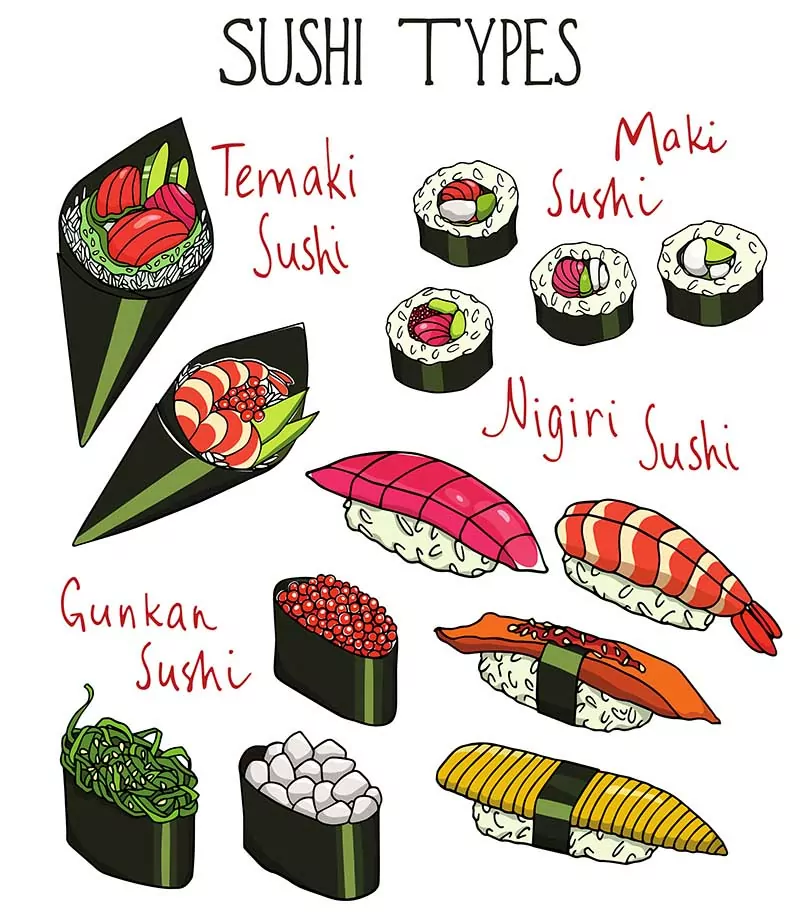
A Breakdown Of The Japanese Staple And Its Varieties
To begin with, let’s clear up the confusion between sushi, sashimi, nigiri, and maki. Nigiri and maki are two distinct kinds of sushi, while sushi is an umbrella term that refers to foods made of vinegared rice and other ingredients. On the other hand, sashimi is not sushi.
Besides nigiri and maki, there are plenty of choices you want to check out when dining out at your local sushi bar. There’s chirashi, uramaki, temaki, and so on. Let’s scroll down and have a look at the summary chart of main sushi types before going into detail!
Nigiri And Its Two Varieties You Should Know
Nigiri is perhaps one of the most popular kinds of sushi. But did you know that it has two other brothers called gunkan maki and temarizushi? Well, it’s not too late now. Let’s say hi to them!
1. Nigiri
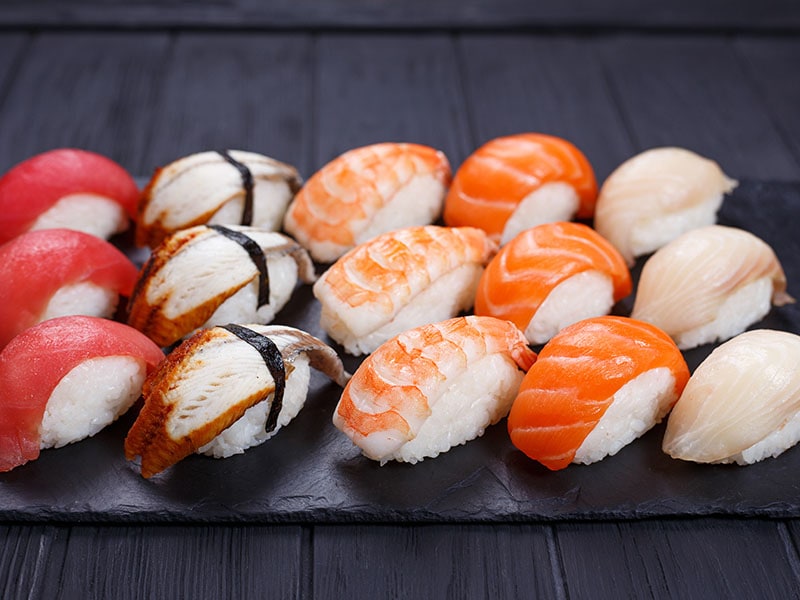
Even when you don’t have a high-rated sushi-making kit, you can still make mouth-watering nigiri rolls effortlessly. The simplest and perhaps the most well-known of its kind, the origin of nigiri lies in the Kanto region around the 1800s.
Nigiri consists of two parts: an elongated ball of vinegared rice and a topping, which can be a piece of fish, shrimp, or omelet. The fish can be cooked or lightly seared and is typically referred to as aburi.
To elevate the taste of nigiri, people will serve this sushi with accompaniments like soy sauce with a dab of wasabi, miso soup, or tempura. While you can use chopsticks, it is advised that you enjoy nigiri with your hands, upside down, and finish a roll in a single bite.
Here’s a quick and detailed guide on making nigiri with perfection.
2. Gunkan Maki (Boat-shaped Maki)
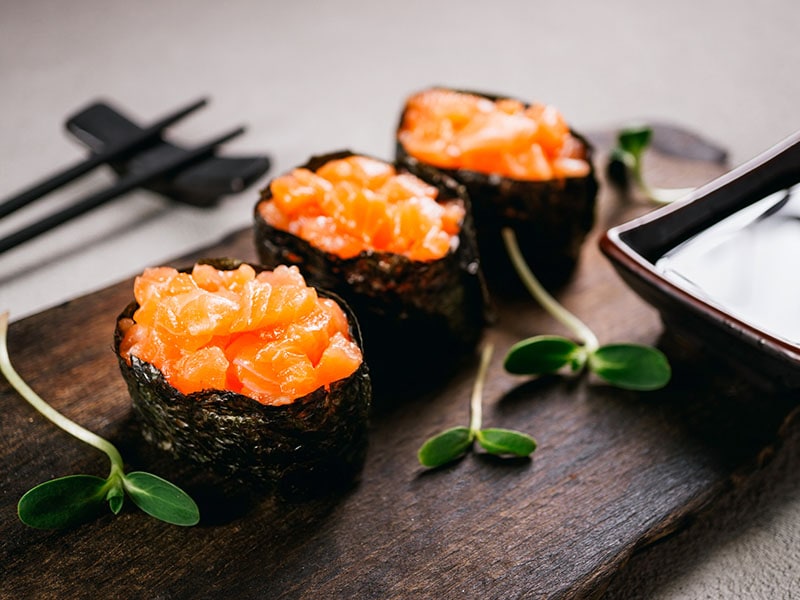
Despite the name, gunkan maki does not belong to the maki group, which will be addressed later in this post.
Gunkan maki means “warship roll” in Japanese, which indicates the distinctive boat shape of this nigiri variant. It is an invention of Ginza Kyubey restaurant in 1941, which started with a joke from a customer saying that he wanted something more unusual on his sushi.
He later proposed that fish roes were a good choice, and the idea came into reality thanks to Chef Imada. Other soft, high-end toppings soon appeared on gunkan maki, from sea urchin to scallops and oysters, and are kept in using a nori strip.
3. Temarizushi
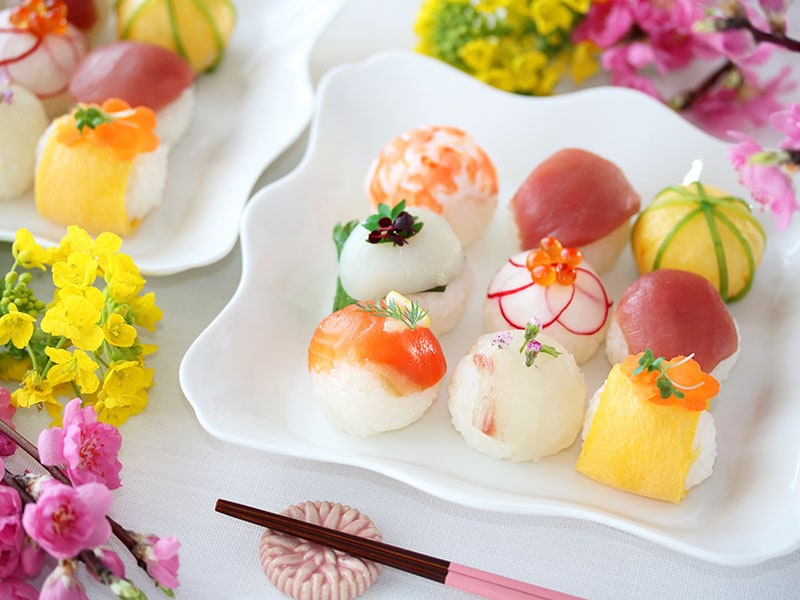
Temarizushi is relatively similar to nigiri, except the rice part is shaped into a ball instead. It tends to focus more on visual presentation, so you should find colorful pieces of seafood and edible garnishings on top of each ball: tuna, salmon, octopus, lotus root slices, etc.
In Japan, people will exchange temarizushi as a gift on special occasions, such as birthdays, Mother’s Day, Valentine’s Day. The sushi also makes an appearance on Hinamatsuri, which is also known as Girl’s Day.
The World Of Maki
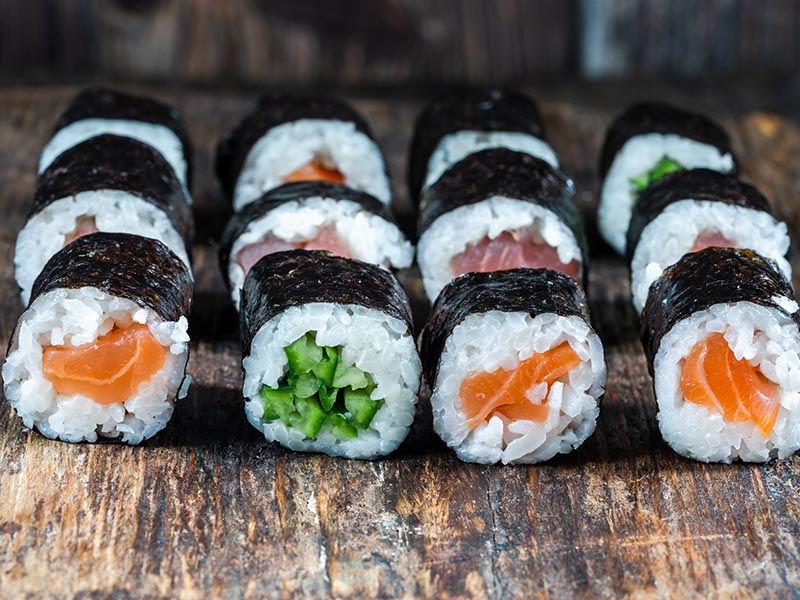
When someone talks about sushi, rest assured maki will pop up in your mind. Each maki roll consists of three components: the seaweed rim, the vinegared rice, and the filling made from different ingredients, such as seafood and vegetables.
The answer for how long the sushi can remain fresh depends on whether the seafood is raw or cooked. For example, raw fish tends to spoil more quickly (after 2 days), while cooked fish can hold up 3-4 days.
In general, maki is classified according to its size, which results in two distinct variants: hosomaki (small maki) and futomaki (large maki). In addition, you have uramaki, temaki, and saikumaki.
Types Of Maki According To Its Size
Simply put, the difference between hosomaki and futomaki is the number of filling. You will also find nakamaki, which is slightly bigger than hosomaki but not as big as futomaki. Yet, it is not too different from its counterparts, so I will omit it.
4. Hosomaki (Small Maki)
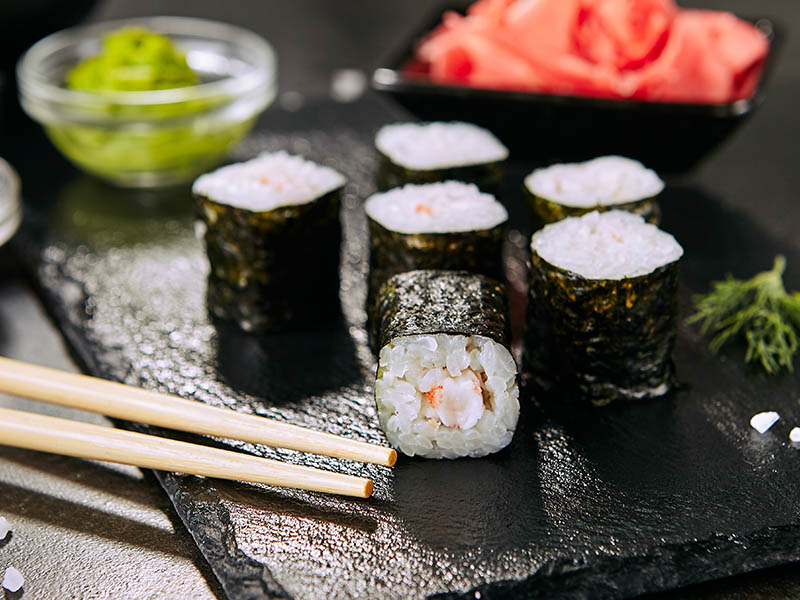
Hosomaki, which literally means thin maki, has only one filling. However, people also use the term to refer to maki rolls with a thickness of 2-3 cm, which can have two or more fillings, but this is not at all correct. The most popular type of hosomaki is tekkamaki (tuna maki).
5. Futomaki (Large Maki)
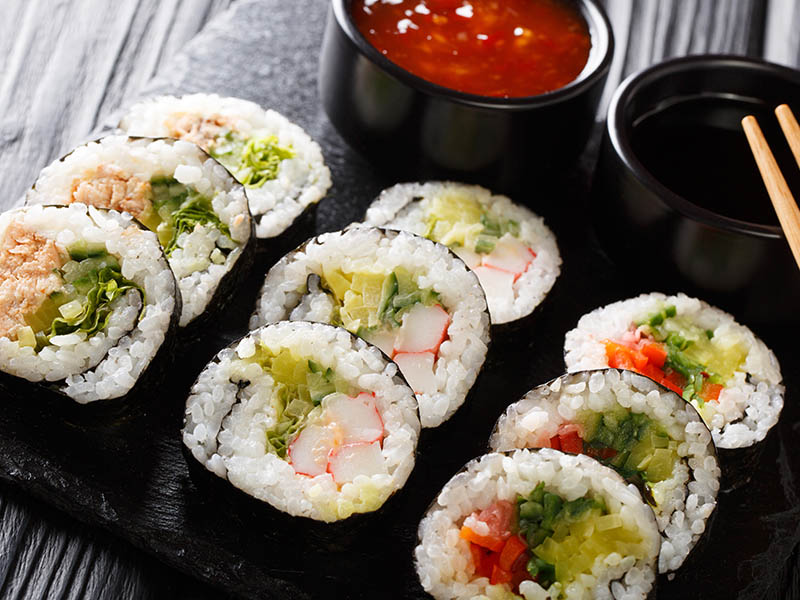
On the other hand, futomaki rolls are much thicker (4-6 cm) and often made from vegetables like cucumber, spinach, and mushrooms. People will serve futomaki on special occasions or whenever a little presentation is needed.
Other Types Of Maki
To start with, you have uramaki, which is maki in its alternate universe. Then, there’s temaki, a type of hand-rolled sushi, and saikumaki, which is more like a form of artful plating rather than a sushi type.
6. Uramaki
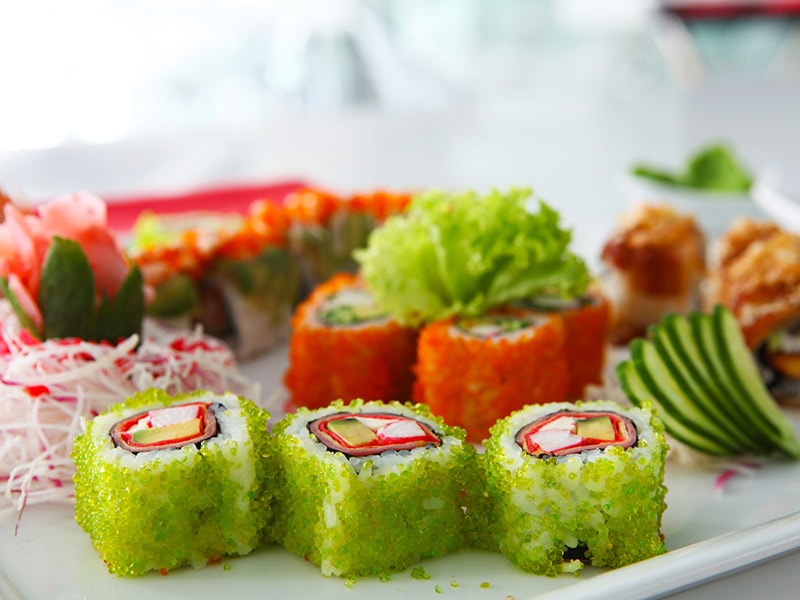
Think of uramaki as the opposite of maki, which means that the rice part goes first, then nori (seaweed) and the filling. Also known as California rolls or the “upside-down” sushi, uramaki has a very interesting history, much like how it is prepared.
In the late 1960s, Tokyo Kaikan, a restaurant based in Los Angeles, faced an issue. The use of seaweed in their sushi rolls did not make American customers happy, so the head chef of the restaurant decided to put the rice on the outside.
Since rice plays a vital part, you should know the high-quality sushi rice brands when making uramaki. As with other sushi, you can put anything you want in your uramaki: shrimp, cucumber, avocado, and so on.
7. Temaki
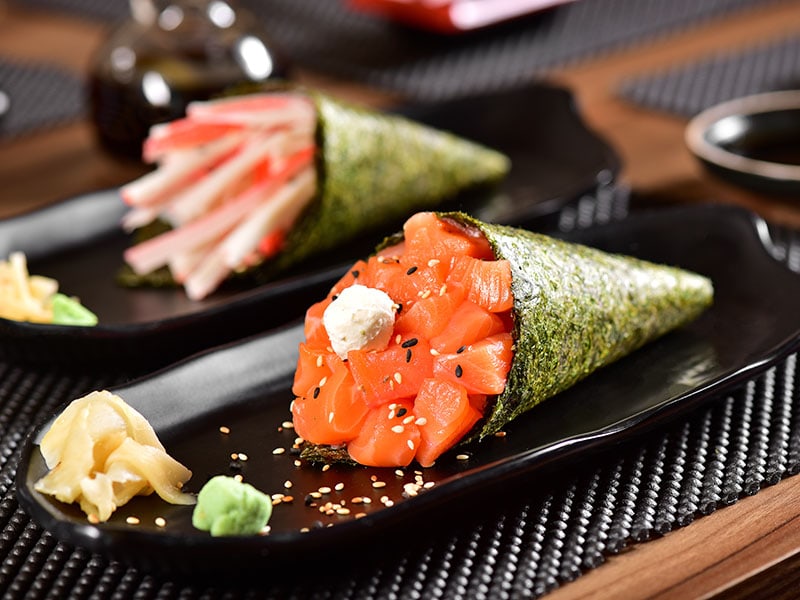
Have you ever been confused about the two terms “sushi roll” and “hand roll”? They are two groups of sushi, categorized according to how they are rolled. While the former are shaped using a bamboo mat, the latter are done by hand and require more expertise.
Temaki is an example of hand rolls. To make it, people will carefully roll the seaweed sheet into a cone and fill the cone with prepared rice, julienned vegetables, and other fillings of choice.
In Western countries, temaki is treated as fast food, and the chances are that you won’t find it in fancy restaurants. The ease of preparation has made temaki one of the biggest culinary trends in the past years, so don’t miss out on it!
Making temaki is straightforward when you stick to these instructions.
8. Saikumaki
Also known as decorative rolls, saikumaki gives precedence to presentation. The sushi rolls are carefully arranged on the plate in the shapes of flowers or family crest. If you wish to impress some sushi lovers at the next gathering, saikumaki could not be anymore downright.
Bring out your inner artist with a beautiful plate of saikumaki.
Sushi Roll, A Western Creation That Goes Beyond Deliciousness
Technically, sushi roll is pretty much the same as maki. It is prepared in a similar manner and also contains ingredients like raw seafood and vegetables (some options are cooked, which are ideal for beginners). The difference is that it focuses more on presentation.
Sushi roll goes by different fancy names, with an example being dragon roll which consists of many colorful ingredients. Some other popular choices include rainbow roll, dynamite roll, spicy tuna roll, and California roll, which is not just pleasant on the eye.
9. Dragon Roll (Most Popular Sushi Roll)
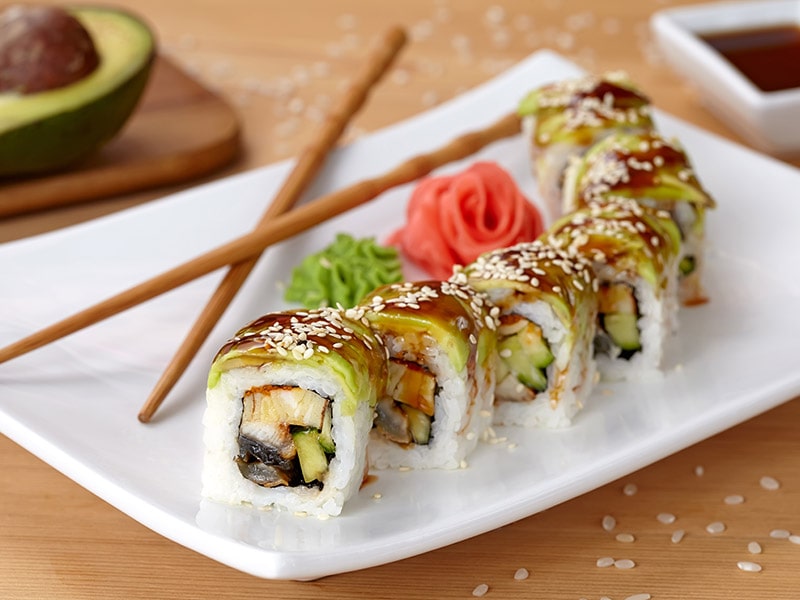
Creamy avocado, crispy tempura, and perfectly tender vinegared rice are the holy trinity of this sought-after dragon roll, which is among the most popular sushi rolls in America. When you slice the roll, the sushi reveals its intricate arrangement that looks like the dragon neck.
10. California Roll (Sushi With No Raw Fish)
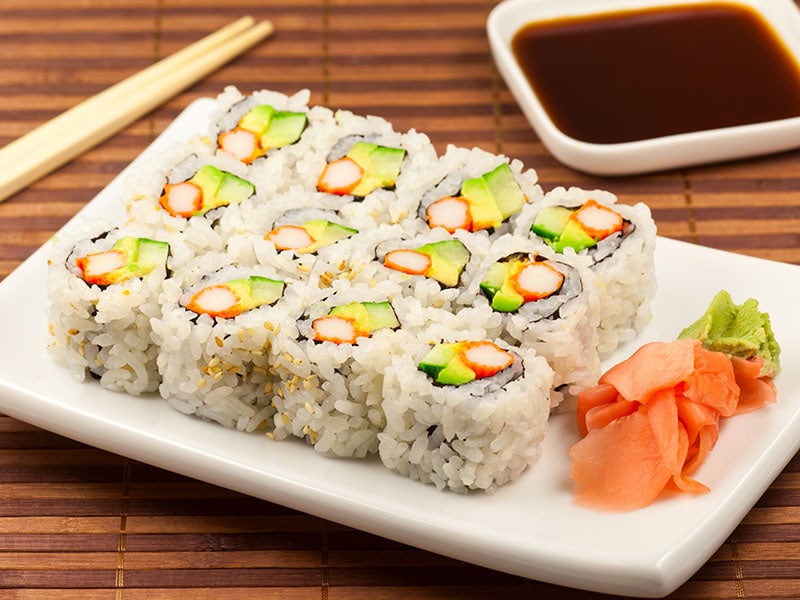
Ranked as the second most demanded sushi roll in America, California roll strikes a perfect balance between look and taste. Although the sushi lacks the freshness of raw seafood, it is still very palatable, especially when enjoyed with pickled ginger, soy sauce, and wasabi.
11. Rainbow Roll
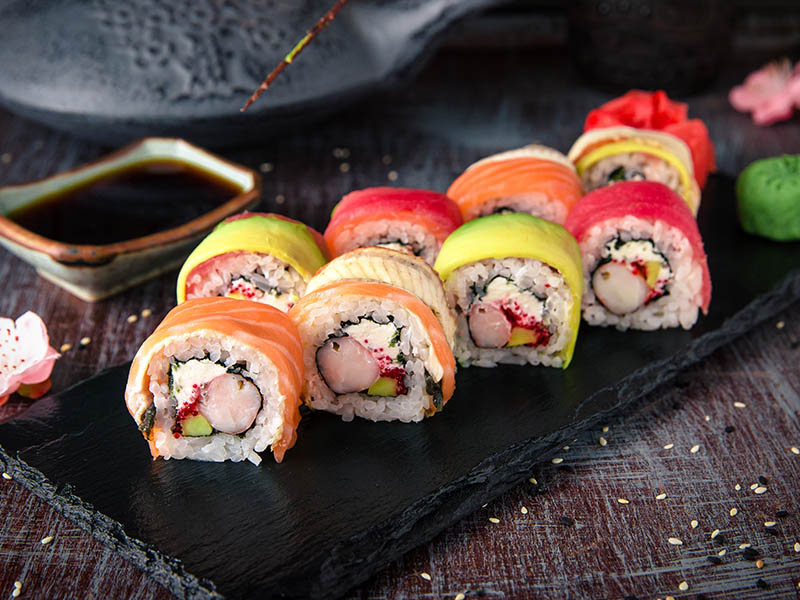
A variation of the California roll, the rainbow roll will tempt you into taking a bite with its vivid colors, which are derived from cucumber, avocado, imitation crab, and a plethora of raw fish like tuna and salmon. It’s the sushi goodness you have been craving!
12. Dynamite Roll (Sushi With Cream Cheese)
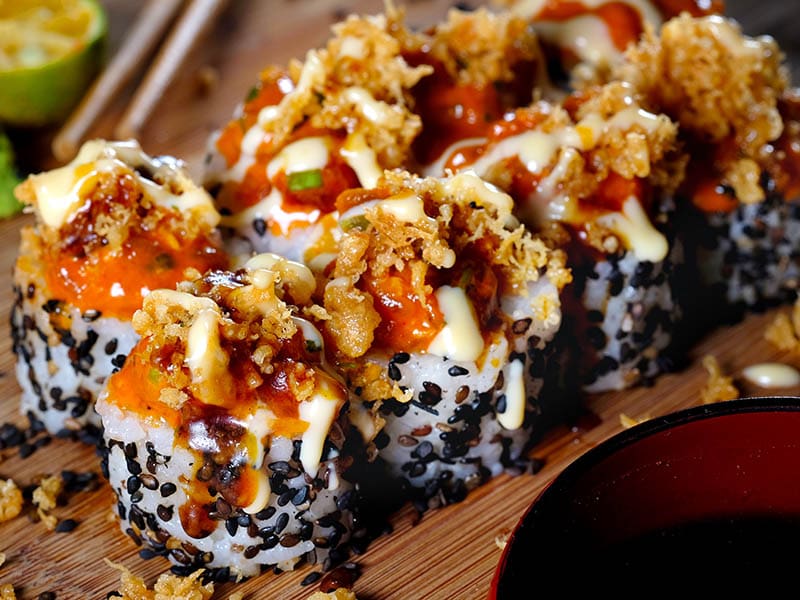
From the name, you can expect how dynamite roll goes in your mouth: a creamy touch from avocado, a pop of freshness from shrimp, and a savory umaminess from soy sauce, oyster sauce, and aioli sriracha. Sounds like a dream team!
13. Spicy Tuna Roll
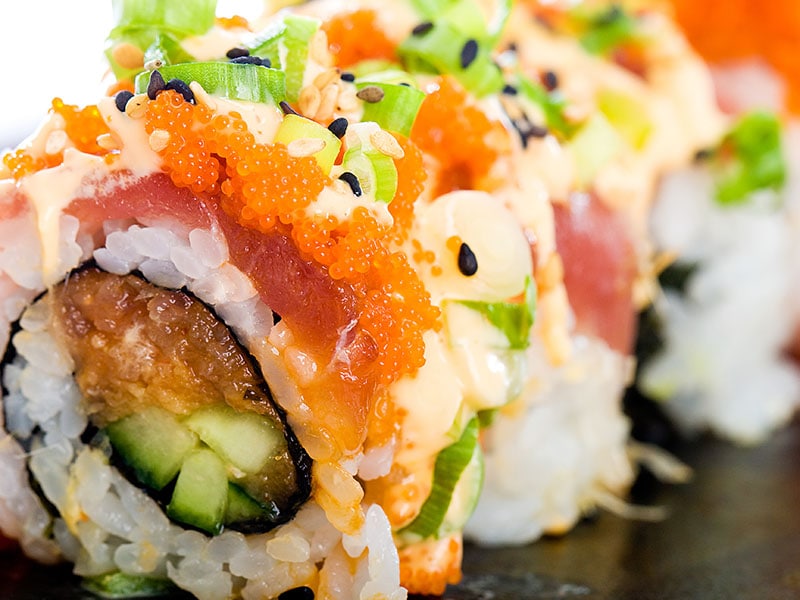
Spicy tuna roll consists of three main ingredients: raw tuna, sriracha, and spicy mayonnaise and is flavored with ichimi togarashi (ground red chile powder) for extra heat. It was invented by Jean Nakayama during the 1980s and did not take long to skyrocket to fame.
Other Kinds Of Sushi You Should Definitely Check Out
Did you know that’s there a type of sushi served in a bowl? How about sushi stuffed in fried tofu? If you have never heard about these delicacies, don’t skip the following section, where I will introduce more regional sushi that you cannot afford to ignore.
14. Chirashizushi (Scattered Sushi)
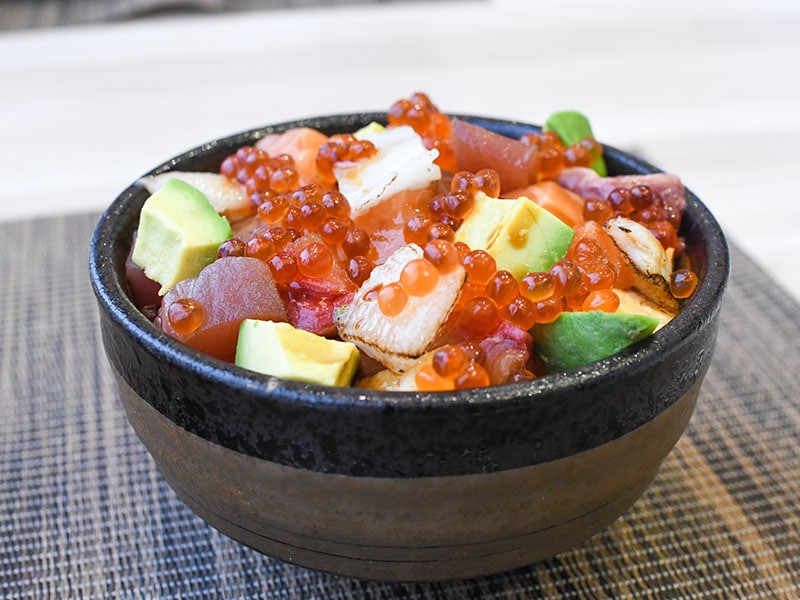
Also known as scattered sushi, chirashizushi is not what you usually think of when someone mentions the Japanese delicacy. It is literally a bowl of rice, which is piled up with several sushi toppings – fish, seafood, vegetables, tofu, and omelet.
Chirashizushi was believed to be a dish that makes use of leftover or unattractive pieces of fish after preparing sashimi. Despite that, chirashizushi has its own curb appeal and can turn into a crowd-pleaser without calling for artful plating.
15. Inarizushi
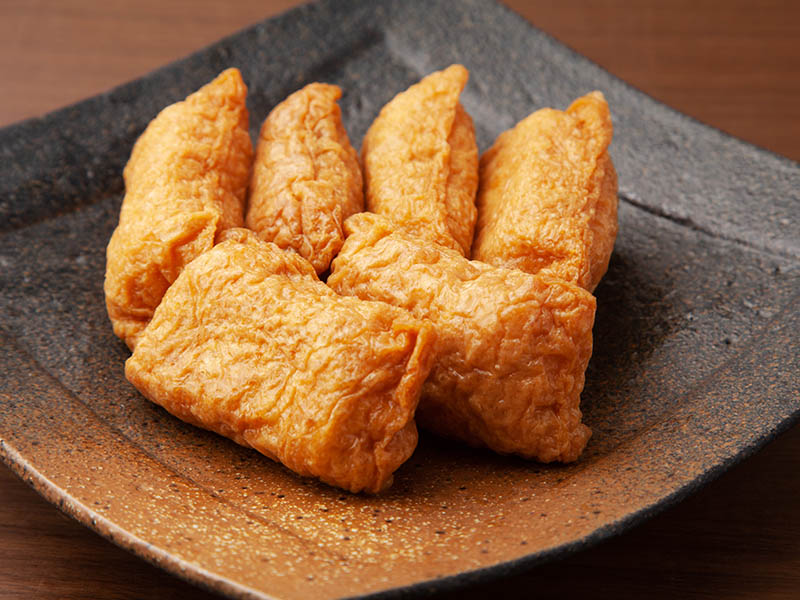
Where’s the rice of this sushi, you ask? It is stuffed inside these fried tofu pouches, which are boiled in dashi stock in advance for extra flavor. Although no other toppings are included, inarizushi is incredibly delicious and typically served with other sushi.
No one knows exactly when this classic Japanese tofu treat came to life, but there’s a tale that the delicacy was named after the Shinto god Inari, whose foxes are obsessed with fried tofu. Therefore, the pouches have pointed corners, which resemble their ears.
16. Oshizushi (Pressed Sushi)
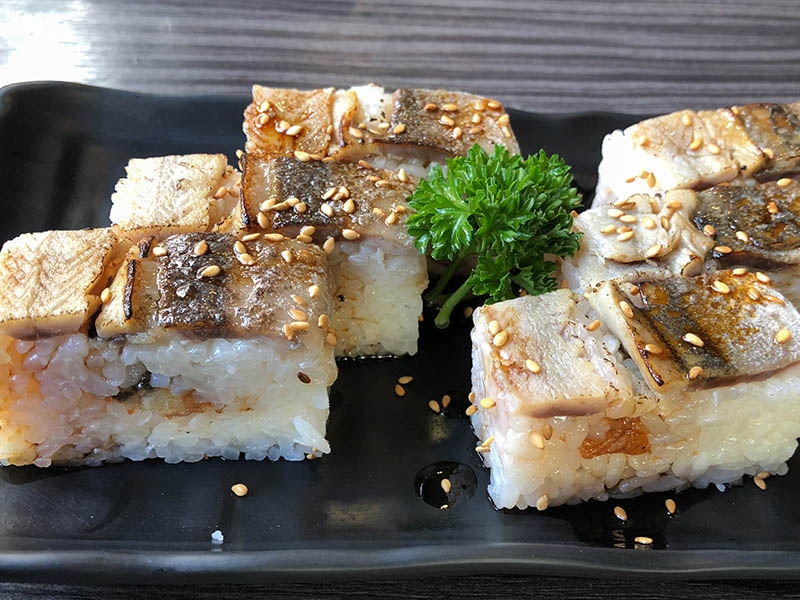
A common concern people have is how long sushi can sit at room temperature without being spoiled. With oshizushi, this is not such a big deal as the fish is cured, which means it should remain fresh for hours. Still, it’s not a good thing to do because you risk losing the freshness.
Oshizushi is meant for the perfectionist. Once the rice is cooked, you will use a special mold called oshibako to press the rice and the sushi toppings. Slice the sushi block into bite-sized pieces, and you have an Instagram-worthy sushi platter that will make everyone jealous!
Much to people’s surprise, oshizushi is one of the oldest kinds of sushi, with its origin dating back to the 15th century. With every bite taken, oshizushi will send you to another taste dimension with its delicate flavors, which are even better when accompanied by soy sauce.
Impress your family and friends with these lovely pieces of oshizushi.
17. Sugatazushi
Sugatazushi is incredibly rare and can be found in a few regions of Japan only. To make this sushi, a whole mackerel is soaked in brine. Then, the itame (sushi chef) will gut the fish, stuff it with rice, and cut them into small pieces.
Sugatazushi has a long history, with its first record going back to the Heian era. Nowadays, it is an indispensable element of autumn festivals in Tokushima. Some prefer to make this dish with bouse or butterfish, which requires no slicing since the fish is small.
Follow this guide and make yourself a crowd-pleasing sugatazushi.
18. Sasazushi
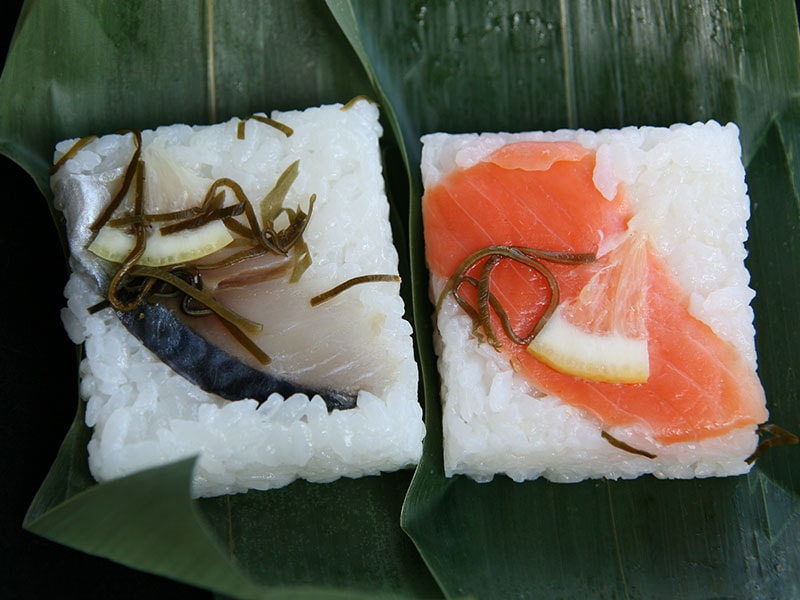
A specialty of Ishikawa that can rarely be found elsewhere, sasazushi has more than just a pretty look. Starting with a small block of rice, people will place a thin slice of salmon or other types of fish on top and double-wrap the food in bamboo leaves.
In Nagano and Niigata prefectures, sasazushi is also topped with condiments. Unlike regular sushi, sasazushi has more pronounced flavors and is highly fragrant, thanks to the wrapping leaves. You will mostly find this dish in the prefectures in the Hokuriku region.
19. Iwakunizushi (Sushi Cake)
Iwakunizushi is a fantastic delight from Yamaguchi. The sushi is composed of several layers: vinegared rice, lotus roots, shiitake mushrooms, and slices of raw fish and is neatly shaped using wooden molds.
As the saying goes, the dish used to be a gift to the deity. Nowadays, iwakunizushi graces its presence in various traditional celebrations with its riot of colors. The Japanese will also treat their guests with this sushi cake using their own wooden mold.
Grab Your Chopsticks And Pour Out The Soy Sauce!
Honestly, these types of sushi are making my stomach growl! Not only do they taste divine, but they also have the best visual appeal in the game. If you are wondering what to make for tonight’s dinner, I’m sure you now have plenty of choices.
Which sushi is your favorite? Share it with other readers and me via the comment section. If you happen to know any different type of sushi, feel free to let me know as well. The more, the merrier!
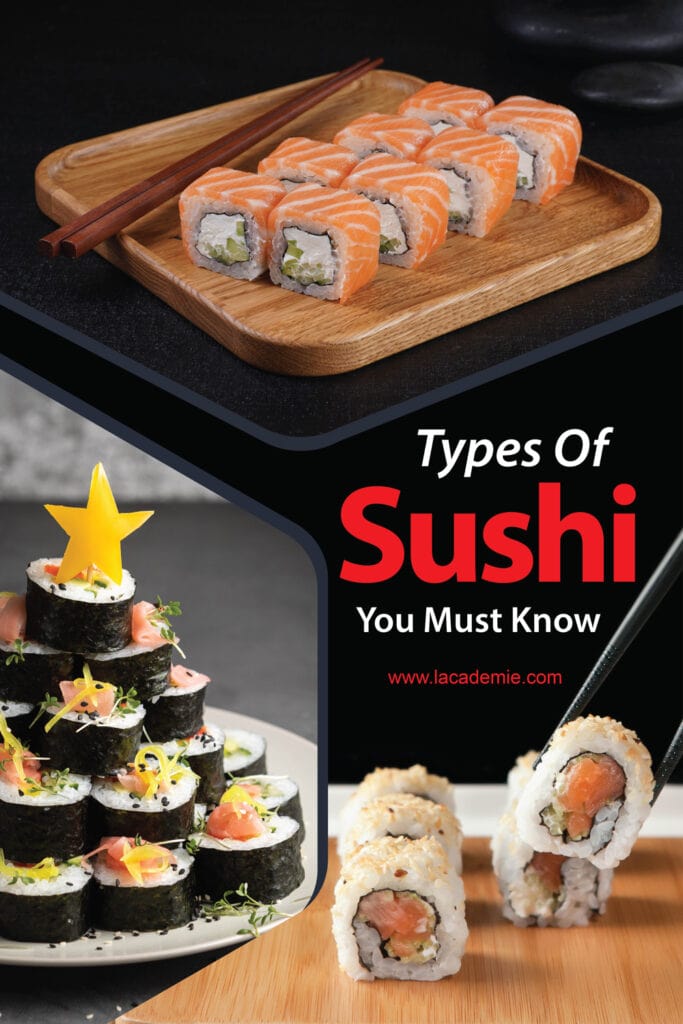

Jamie Scott
Editor in Chief, Senior Content Writer
Expertise
Home Cooking, Meal Planning, Recipe Development, Baking and Pastry, Food Editor, Cooking-video Maker, Western Food Evaluation Expert
Education
Le Cordon Bleu College of Culinary Arts
Local Community College, New York, NY
Jamie Scott is a skilled culinary expert and content creator specializing in Western cuisine. With over 15 years in the culinary field and formal training from Le Cordon Bleu, Paris, Jamie deeply understands how to blend nutrition with delicious flavors. His passion for cooking matches his commitment to making healthy eating accessible and enjoyable.
On Fifteen.net, Jamie brings a fresh perspective to classic dishes and beverages, offering readers insightful recipes, cooking tips, and a fresh view on meal planning that emphasizes taste, health, and simplicity.